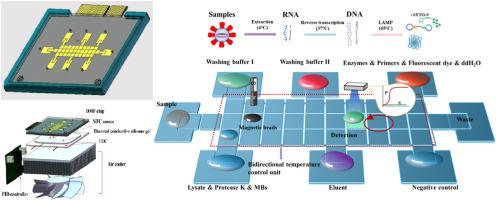利用双模热控数字微流控芯片自动集成检测核酸
IF 5.7
2区 化学
Q1 CHEMISTRY, ANALYTICAL
引用次数: 0
摘要
核酸检测通常包括核酸提取、反转录和扩增,是分子诊断的重要组成部分。然而,传统方法存在一些局限性,包括高度依赖熟练人员、自动化程度低和检测时间长。此外,这些方法还需要为不同的步骤划分不同的区域,以避免污染。虽然已有许多数字微流控(DMF)芯片用于检测核酸的报道,但能够同时进行核酸提取、扩增和信号检测的全集成 DMF 平台却明显缺乏。在此,我们开发了一种与双模热控模块相结合的 DMF 芯片,以实现核酸的自动集成检测。双模式热控制模块为核酸检测的所有步骤提供了所需的温度(范围从 4°C 到 95°C)。为了证明 DMF 芯片的可行性,我们选择了 SARS-CoV-2 和猴痘伪病毒,所有检测均在 40 分钟内完成。结果表明,4°C条件下提取的产物浓度高、完整性好,与传统方法的产物相当。扩增仪的分析性能与传统方法相当,而且设计更紧凑、时间更短、体积更小、操作更自动化。DMF 芯片具有双模温控和全自动操作的能力,实现了样本进结果出的核酸检测,在体外诊断和护理点检测等领域大有可为。本文章由计算机程序翻译,如有差异,请以英文原文为准。


Automatic and integrated detection of nucleic acid by using a dual-mode thermal controlled digital microfluidic chip
The detection of nucleic acids, which typically consists of nucleic acid extraction, reverse transcription and amplification, is a crucial component of molecular diagnostics. However, traditional methods have several limitations, including high reliance on skilled personnel, low degree of automation and lengthy assay times. Additionally, these methods also require separate areas for the different steps to avoid contamination. Though a number of digital microfluidic (DMF) chips have been reported to detect the nucleic acids, but there is a noticeable absence of fully integrated DMF platforms capable of concurrently performing nucleic acid extraction, amplification, and signal detection. Here, a DMF chip combined with a dual-mode thermal control module was developed to realize the automatic and integrated detection of nucleic acids. The dual-mode thermal control module provided the required temperatures (with a range from 4 °C to 95 °C) for all the steps of nucleic acid detection. Pseudoviruses of SARS-CoV-2 and monkeypox were chosen to demonstrate the feasibility of the DMF chip, and all assays were completed within 40 min. The results confirmed that the products extracted under 4 °C exhibited high concentration and integrity, which were comparable to those by traditional methods. And the analytical performance of amplify was comparable to that of traditional methods with a more compact design, shorter time, smaller size and more automatic operation. With the ability of dual-mode thermo control and full automatic operation, nucleic acid detection with the characteristics of sample-in-result-out was realized on the DMF chip, which holds great promise in fields such as in vitro diagnostics and point‐of‐care testing.
求助全文
通过发布文献求助,成功后即可免费获取论文全文。
去求助
来源期刊

Analytica Chimica Acta
化学-分析化学
CiteScore
10.40
自引率
6.50%
发文量
1081
审稿时长
38 days
期刊介绍:
Analytica Chimica Acta has an open access mirror journal Analytica Chimica Acta: X, sharing the same aims and scope, editorial team, submission system and rigorous peer review.
Analytica Chimica Acta provides a forum for the rapid publication of original research, and critical, comprehensive reviews dealing with all aspects of fundamental and applied modern analytical chemistry. The journal welcomes the submission of research papers which report studies concerning the development of new and significant analytical methodologies. In determining the suitability of submitted articles for publication, particular scrutiny will be placed on the degree of novelty and impact of the research and the extent to which it adds to the existing body of knowledge in analytical chemistry.
 求助内容:
求助内容: 应助结果提醒方式:
应助结果提醒方式:


